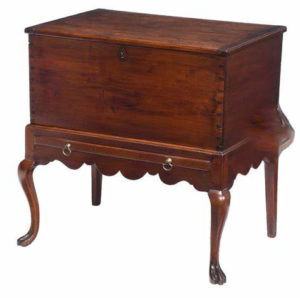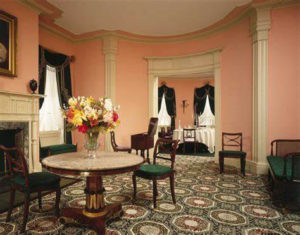The Brooklyn Museum recently succeeded in deaccessioning several rooms of antique furniture and decorative art, a process often regarded with skepticism within the museum community. Typically, there are strict guidelines governing deaccessioning, including the requirement that any funds generated must be earmarked to acquire new works. Moreover, curators must provide:
A comprehensive list of reasons justifying the removal of the items.
Citing factors such as poor condition.
Inability to adequately care for the pieces.
Misalignment with the museum’s mission or goals.
Even when executed according to these guidelines, deaccessioning can still provoke controversy, as seen in the recent sale of a Gilbert Stuart portrait of George Washington by the Metropolitan Museum.

Chippendale Walnut Fitted Cellaret Courtesy: Brunk Auction
Founded in 1895 as the Brooklyn Institute of Arts & Sciences, the Brooklyn Museum originally served as a cultural institution for the independent city of Brooklyn before its incorporation into New York City in 1898. Over the years, the museum has faced challenges akin to a spring-cleaning dilemma, necessitating difficult decisions to optimize space and financial resources. In this vein, the recent decision to part ways with four period rooms reflects a bittersweet yet necessary process.
The museum entrusted the contents of these rooms to Brunk Auctions of Asheville, North Carolina, leading to a remarkable auction event featuring hundreds of objects spanning various periods and regions. From delicate ceramics to robust furniture, the auction presented a whirlwind journey through history, with esteemed names like Matthew Bolton and Le Corbusier adding prestige to the proceedings.

Abraham Harrison House Architectural Elements
Courtesy: Brunk Auctions
The auction surpassed expectations, raising over $678,000 — more than two-and-a-half times the initial estimate of $254,000. Notably, an eighteenth-century Virginia Chippendale walnut cabinet fetched $95,000 ($116,850 with premium), well above its estimated value of $40,000. Other highlights included furnishings from the Abraham Harrison House and woodwork elements from the dining room at Cane Acres Plantation, which exceeded their estimated values.
Despite the financial success, the museum’s decision sparked debate among critics, who questioned the implications of selling historical artifacts and its potential impact on the institution’s identity. However, the museum’s director, Anne Pasternak, defended the move as a strategic effort to create space for new acquisitions while maintaining the museum’s core ethos—a delicate balance between honoring tradition and embracing progress.
Brooklyn Museum Sells Out
The Brooklyn Museum recently succeeded in deaccessioning several rooms of antique furniture and decorative art, a process often regarded with skepticism within the museum community. Typically, there are strict guidelines governing deaccessioning, including the requirement that any funds generated must be earmarked to acquire new works. Moreover, curators must provide:
A comprehensive list of reasons justifying the removal of the items.
Citing factors such as poor condition.
Inability to adequately care for the pieces.
Misalignment with the museum’s mission or goals.
Even when executed according to these guidelines, deaccessioning can still provoke controversy, as seen in the recent sale of a Gilbert Stuart portrait of George Washington by the Metropolitan Museum.
Chippendale Walnut Fitted Cellaret Courtesy: Brunk Auction
Founded in 1895 as the Brooklyn Institute of Arts & Sciences, the Brooklyn Museum originally served as a cultural institution for the independent city of Brooklyn before its incorporation into New York City in 1898. Over the years, the museum has faced challenges akin to a spring-cleaning dilemma, necessitating difficult decisions to optimize space and financial resources. In this vein, the recent decision to part ways with four period rooms reflects a bittersweet yet necessary process.
The museum entrusted the contents of these rooms to Brunk Auctions of Asheville, North Carolina, leading to a remarkable auction event featuring hundreds of objects spanning various periods and regions. From delicate ceramics to robust furniture, the auction presented a whirlwind journey through history, with esteemed names like Matthew Bolton and Le Corbusier adding prestige to the proceedings.
Abraham Harrison House Architectural Elements
Courtesy: Brunk Auctions
The auction surpassed expectations, raising over $678,000 — more than two-and-a-half times the initial estimate of $254,000. Notably, an eighteenth-century Virginia Chippendale walnut cabinet fetched $95,000 ($116,850 with premium), well above its estimated value of $40,000. Other highlights included furnishings from the Abraham Harrison House and woodwork elements from the dining room at Cane Acres Plantation, which exceeded their estimated values.
Despite the financial success, the museum’s decision sparked debate among critics, who questioned the implications of selling historical artifacts and its potential impact on the institution’s identity. However, the museum’s director, Anne Pasternak, defended the move as a strategic effort to create space for new acquisitions while maintaining the museum’s core ethos—a delicate balance between honoring tradition and embracing progress.